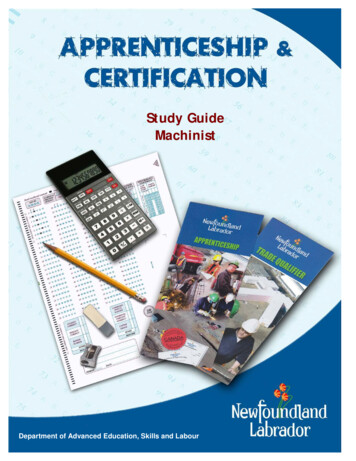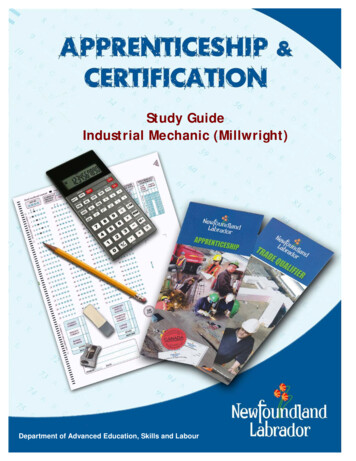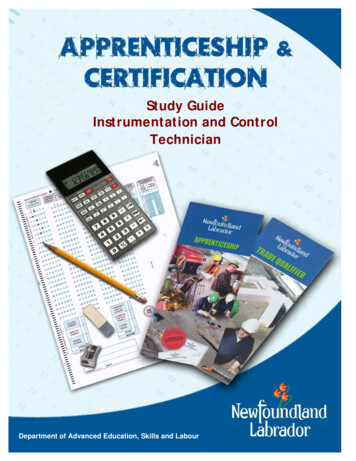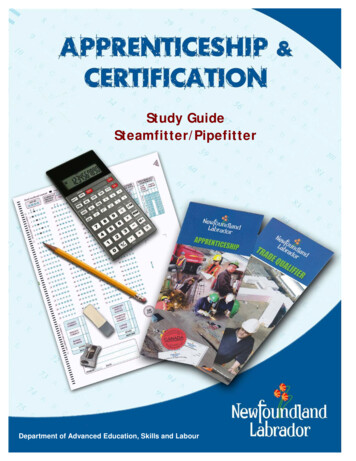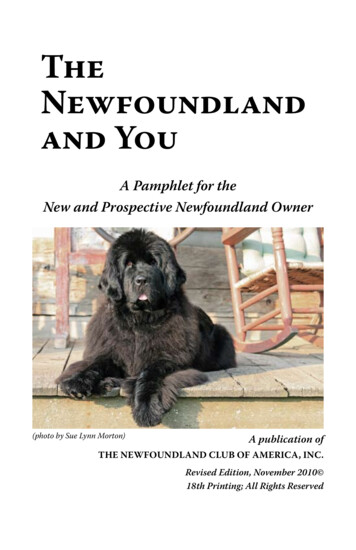
Transcription
TheNewfoundlandand YouA Pamphlet for theNew and Prospective Newfoundland Owner(photo by Sue Lynn Morton)A publication ofThe Newfoundland Club of America, INC.Revised Edition, November 2010 18th Printing; All Rights Reserved
BLANK
Introducing the NewfoundlandThe Newfoundland is a large, strong, heavy-coated, active dog, equally athome in the water and on land. He is a multipurpose dog, capable of heavywork. While at first the Newf may appear somewhat placid, he is actuallya fairly active dog that enjoys and needs daily exercise. Despite his size, hecan reside comfortably in a small home or apartment, provided he is givenample opportunities for exercise.Newfoundlands are renowned for their unique gentleness, even temperament, loving nature, and devotion. Historically, they have displayed a keensense of responsibility and life-saving instincts, and their acts of heroism,both on land and on sea, are recorded in history, myths, and legends. Theseattributes make a Newf a good choice as a companion for children andadults alike.While Newfs are well known for their gentle disposition, personality andtemperament can vary throughout this breed, just as with humans. Whilethe Newf has strong guardian instincts, he is not a watchdog, and harshtreatment and inattention will produce resentment and poor behavior inany dog. In addition, one should see that a Newf (or any dog) is not abusedor harassed by children or adults. A growing puppy may be more subject toinjury than his size would lead you to believe. Never allow a child to climbon a growing puppy or ride on an adult Newf.The oily nature of the Newfoundland’sdouble coat effectively keeps him fromgetting wet to the skin, and combinedwith his webbed feet, deep, broadchest, and well-sprung ribs contributes to his swimming ability. Despitethis heavy coat, he adapts to warm aswell as to cool climates. In warm climates, the long outer coat remains,but the undercoat thins out to somedegree. The warmer the weather, themore careful you must be to avoidoverheating. Also provide a Newfwith plenty of shade and fresh waterand do not leave him in the sun or unattended in a parked car.—1—
Historically, in Newfoundland, he was used as a working dog to pull netsfor the fishermen and to haul wood from the forest. Elsewhere he patiently did heavy labor of all kinds, powering the blacksmith’s bellows and theturner’s lathe.There are many conflicting stories as to the origin of the Newfoundland. It isagreed only that he is one of the older breeds of dogs in existence today. Hemay not have originated in Newfoundland, though skeletons of giant dogshave been discovered in Indian gravesites in Newfoundland dating fromthe 5th century, AD. One of the more appealing speculations rests on thelegend that when Leif Erikson arrived in North America about 1000 AD, alarge black dog, resembling a Newfoundland, called Oolum, was aboard hisboat. It is recorded that early in the 18th century some Norwegians keptand used Newfoundland-like dogs for bear and wolf hunting.The first record of the Newfoundland dog on the island whose name hebears dates from 1732 when an unknown author wrote, “The Bear Dog ofa very large size is very watchful, his business is to guard a court or house,and has a thundering voice.” It ispossible, too, thatsome Great Pyrenees were bred tothis Newfoundlanddog by the Basquefishermensailing between Newfoundland and theirhomeland.The Newfoundlandbreed as we know it today was developed largely in 19th century Englandand America. The Newfoundland is an ancestor of the present day Labrador and Chesapeake Bay Retrievers, which follow the Newfoundland intheir natural swimming ability. The rough-coated St. Bernard owes its coatto the Newfoundland.The Standard—written by the Newfoundland Club of America and approved by the American Kennel Club—calls for a dog that impresses theeye with great strength, dignity and pride. The Newf in motion gives theimpression of effortless power. Good proportion is important for a smooth,—2—
strong drive. The Newfoundland has a water-resistant double coat. The outercoat is coarse, moderatelylong and flat. The undercoatis soft and very dense. TheStandard calls for sweetnessof temperament as the hallmark of the breed.While the Newf is found in avariety of coat colors, coloris secondary to breed type,structure and soundness.The recognized colors in the Standard are black, brown, gray, and whiteand black. Black, brown and gray may appear as solid colors or solid colorswith white on the chin, chest, toes, and tip of tail. Also typical is a tinge ofbronze on a black or gray coat and lighter furnishings on a brown or graycoat. While not common, brown or gray Newfs are not considered unusualand should not be sold at a higher price than other colors.A white and black dog has a white base coat with black markings. In thepast, these have been called Landseers because their coloring is typical ofNewfoundlands painted by Sir Edwin Landseer. The head is solid black orblack with white on the muzzle, with or without a blaze (a white stripe extending from the muzzle between the eyes onto the head). There is a separate black saddle and black on the rump extending onto a white tail. Clearwhite or white with minimal ticking on the white and black dog is preferred. Other color combinations may occasionally be found, but they arenot recognized in the Standard; these dogs may be AKC registered and cancompete in performance events, but cannot compete in the breed ring.A Newfoundland puppy normally grows at a very rapid rate. The averageheight at the shoulder is 28 inches for adult dogs and 26 inches for adultbitches. Adult dogs typically weigh between 130 and 150 pounds and bitches between 100 and 120. Large size is desirable, but never at the expense ofbalance, structure, and correct gait.Once the Newfoundland breed has caught your eye, you should take timeto learn as much as you can about the breed before you invest in a cutepuppy. There are many ways to further your education, such as going to—3—
dog shows and meeting Newfs and their owners at regional Newfoundlandclub events. You will also find valuable information about the breed on theNewfoundland Club of America (NCA) website (ncanewfs.org).Love does seem to be a warm puppy, but slow down and see if an adultNewfoundland is what you want to live with for the next 10 years or so.In addition to their size, Newfs also come with drool and lots of shedding.(Be wary of breeders who claim their dogs never drool!) Acquiring any dogshould be a family decision made with the intention of keeping the dog forever. Telling a child, “You can have a dog as long as you take care of it, but ifyou don’t, we’ll get rid of it,” is not fair to the dog. It is also a poor lesson forthe child—it tells him a once loved, living creature can be easily disposed ofwhen it becomes a bit of a bother. If you have any doubt about your abilityto afford the dog or to take proper care of it, don’t get one.Selecting Your NewfoundlandSelecting the right breeder can be the most important step you will take.Good breeders are most likely to be members of the NCA. While we cannot select a specific breeder for you, the Newfoundland Club of America (NCA) has some suggestions to help you. The Newfoundland Club ofAmerica and most of the regional clubs provide referrals to Newfoundlandbreeders, usually through a Breeders List that is available on their websites. This is an excellent way to find a breeder. Some breeders encourageprospective puppy buyers to visit their dogs, even if they have no puppiesavailable at the time. Often they can refer you to other breeders, who mayhave puppies or a litter due.(photo by Andrew Patterson)—4—
Anotherexcellent way to meetbreeders is at a dogshow. To find outwhen and wherea show will beheld in your area,check with the regional Newfoundland club in yourarea, refer to theAmerican KennelClub website (akc.org), or do an internet search for(photo by Ruby Silver)“dog show superintendents.” When you find a conveniently located show, check the appropriate website about a week before the show to learn the time Newfs will beshown and how many are entered. At the show, talk to the exhibitors—afterthe judging of Newfs is finished— and ask lots of questions. Although notall exhibitors will be breeders, most of them will be glad to tell you abouttheir dogs and the dogs’ breeders. When you watch the dogs being judged,you will notice that not all Newfs are identical in either appearance or personality, and you will probably prefer “the look” of some better than others.While searching for a breeder, do not be taken in by fancy websites or ads.Beware of a breeder who has not done health checks on the sire and dam.(These records can be seen at offa.org.) Also beware of purchasing a puppy,sight unseen, over the Internet. A reputable breeder will want to establisha relationship with you before placing one of his puppies in your care. Aresponsible breeder will not sell a puppy to just anyone with a credit cardas though the buyer were purchasing some inanimate object. Reputablebreeders have a life-long interest in the dogs they produce. Also bewareof a breeder who promises more or less than others, or whose price quotations are much higher or lower than others. Remember, however, thatNewfoundland puppies can vary in cost depending on age and potentialquality.If possible, visit the breeder personally, even if this means a long drive. A—5—
visit will enable you to meet the breeder, the dam, the litter. You will alsosee the conditions in which the puppies are being raised. Although elaborate equipment is not a necessity, the facilities can and should be clean. Agood breeder will also question you during the visit about your plans andyour own facilities for a Newfoundland. A good breeder also may be rightfully concerned if you do not have a fenced yard, because no breeder wantsto hear that your Newf has run away or was hit by a car.Many Newf owners, however, are delighted with dogs they bought sightunseen from breeders they have never met face-to-face. Indeed, some ofthe best-known kennels have shipped puppies all over North America andeven to remote corners of the world. If a visit to a breeder of interest to youis not practicable, plan to spend some time on the phone or emailing. Goodbreeders are proud of their reputations and will be happy to refer you tosatisfied puppy buyers and introduce you to long-standing Newf fanciers.If you and the breeder decide that you will be taking a puppy from a litter,the breeder will help decide which puppy should become a part of yourfamily. Breeders know the personalities of their puppies and this is essentialto taking home a puppy that will fit your life style and expectations. Bewareof the breeder who wants to sell you a puppy less than eight weeks of ageor wants to sell you two puppies from the same litter. Reputable breederswill typically keep the puppies until at least eight weeks of age. By that time,they will have been examined by a board-certified cardiologist for inheritedheart problems, given at least one series of vaccinations, and declared freeof all parasites.Good breeders are most likely to be members of the NCA. You are farless likely to obtainsatisfaction in dealing with an Internetbreeder, commercial outlet, or a petstore. Good breeders will never sell topet shops or puppymills. While theseestablishmentsfrequentlyobtainstock that cannot be(photo by Douglas A. Gundersen)—6—
sold on a breeder’s reputation, they typically charge more for a mediocreor poor specimen than a good breeder will ask for one of his outstandingprospects. A reputable breeder will follow the development of his stock,while a dealer probably will have no interest after the completion of thesale. The Newfoundland Club of America prohibits its members from selling to pet shops.A Newf puppy from anAKC registered litter willbe eligible for individual registration with theAmerican Kennel Club,the principal registry forpurebred dogs in the U.S.When buying a puppy, youshould be given either anAKC registration application with the litter numberon it, or the AKC registration certificate with the in- (photo by Andrew Patterson)dividual dog’s registered name and number on it, properly signed. AKC hasavailable two different registration certificates: Regular AKC registration(white certificate with purple border) and Limited Registration (white certificate with orange border). Regular AKC registration entitles the dog tocompete in all AKC and NCA events, and the offspring of a dog with fullregistration is eligible for registration. On the other hand, dogs on LimitedRegistration may compete in all NCA and AKC events, except conformation, and their offspring cannot be registered. Regardless of an individualNewf ’s potential for breeding or showing, responsible breeders use LimitedRegistration to prevent the dog from being bred; however, the breeder canchange the registration from Limited to Regular if circumstances warrant.Insist that the breeder provide a written contract when a puppy is purchased. If for some reason the breeder or seller cannot provide the AKCregistration application at the time of sale, a written promise of when it willbe provided should be part of the contract. The breeder should also providesuch pertinent data as whelping date, sire, dam, pedigree, health records,and recommended diet and feeding schedule.The pedigree is a four or five-generation history of your dog’s ancestry (a—7—
family tree). A conscientious breeder,who has spent timestudying and working with the breed,should offer to explain the qualifications of the parentsand why they werea proper mating.It is nice to haveaNewfoundlandwith many champions in the first three(photo by Cissy Sullivan)generations, but it iseven more important that the parents be of proven breeding quality. Occasionally good breeding quality dogs may not have been shown, but doproduce quality puppies when properly mated.AKC registration and/or pedigree is no guarantee of the quality of the puppy. Puppies can be evaluated as possessing show potential or as pet quality, but breeders differ in their approaches to evaluating puppies. A showprospect puppy is one that possesses the potential of meeting the breedStandard and exhibiting virtues of the breed with the absence of disqualifying faults. Such show prospects may or may not make good breeding stock.A breeding quality dog, generally a superior representative of the breed, isusually determined only after the dog has matured and has been evaluatedfor hereditary defects. Health records are available on open databases, suchas those maintained by the Orthopedic Foundation for Animals (OFA) andthe NCA.Pet quality dogs are just as enjoyable as family companions as dogs shownin the conformation ring. Usually they should be spayed or neutered. If youplan to show in conformation, discuss this with your breeder. Spayed andneutered Newfs may compete in AKC performance events and in NCAwater or draft tests.The breeder will assist you in selecting a puppy, but you should be attractedto the sire and dam of your puppy, because the puppy will probably matureto be somewhat similar to his parents in temperament, appearance, and—8—
personality. At first glance, all the puppies may look alike to you. But lookclosely. They are all at least a little different in looks and movement, andeach has a personality all its own. Above all, choose a puppy in good health.Unfortunately, quality is only an educated guess when the puppy is only tenweeks old, and if you are interested in showing, there is no sure-fire methodof selecting the puppy that will be successful in the show ring.You must allow for changes as the puppy matures. Most Newfs go throughsome awkward stages, especially during the first year, and at times seemto be all ears, all legs, or awkward because of uneven growth. Be patient;most will mature to be beautiful adults. The first year the puppy will get itsheight, the second and third years it acquires muscle and rib spring, and thefourth year it reaches maturity.Your breeder will have a sales contract or agreement, which you shouldreadcarefullyand discuss indetailbeforesigning.Mostcontracts contain provisionsfor dealing withhealth problemsthat may developand the care required to be provided by the newowner, such as (photo by John Bonnell)diets and neutering. As there is much discussion and controversy concerning these subjects, the buyer should discuss these topics individually withthe breeder. Also, the Newfoundland breed is subject to heart defects andother hereditary conditions. No bloodline is absolutely free of all hereditary problems, but a breeder should be ready to discuss openly any dogs inhis kennel and their pedigree. All breeds have tendencies toward varioushereditary defects that require consideration in choosing a puppy.The AKC requires that breeders keep full and accurate records of their litters. All responsible breeders are interested in the progress of their puppies.If for some reason you are unable to keep your Newf, the first person youshould contact is the breeder. A reputable breeder will take the dog back,—9—
regardless of the dog’s age, orwill find it a new home. If youfind a new home for the dog,the breeder will want to havethe name and address of thenew owner. If you are unable tocontact the breeder, the NCAstrongly recommends that youdo not place the dog in a shelteror rescue program not affiliatedwith the NCA or one of its regional clubs. In the best interest of your Newf, please contactthe NCA or the regional club inyour area for help through theclubs’ rescue programs (ncarescue.org). The NewfoundlandRescue Network maintains awaiting list of pre-screened (photo by Michelle Alpern)adoptive homes that are interested in acquiring a Newfoundland from theNetwork.Health ConsiderationsNewfoundlands, like all purebred dogs, are vulnerable to some extent toparticular health problems, most of which also occur in other large and giant breed dogs. (Do not be misled into believing that mongrels are superiorin this respect; they lack a basis on which the likelihood of hereditary disease can be evaluated.) Since these major health problems are not alwaysoutwardly evident in young dogs and have at least a modest genetic component, responsible breeders test (e.g., x-rays, blood tests) breeding stockprior to breeding.No bloodline is absolutely free of all hereditary problems. In particular,the Newfoundland Club of America considers it necessary to test for fourdisorders (hip dysplasia, elbow dysplasia, cystinuria, and heart disease(particularly sub-aortic stenosis). Many breeders also test patellas, eyes,and thyroid. Only one of these, cystinuria, has a simple inheritance and agenetic test allowing breeders to completely avoid producing the disease.The others have complex inheritance in which there will be no complete— 10 —
guarantee that a puppy will not develop a problem as it grows into adulthood. Thus, in spite of pre-breeding clearances on both sire and dam, it isstill possible that one or more of these diseases can occur.Hip DysplasiaHip dysplasia refers to a syndrome in which malformation of the hip jointoccurs during development. The end results are arthritic changes and remodeling in the joint, which may lead to substantial disability and pain,particularly as the dog ages. There is considerable variability in the degreeof difficulty individual dogs experience. Some with very poor x-ray resultshave few, if any, mobility problems, while others, with seemingly mild arthritic changes, experience more severe symptoms.There are a variety of treatments available. Many dogs do well with conservative treatment—e.g., a variety of pharmaceuticals, such as Adequan andglucosamine/chondroitin, as well non-steroidal anti-inflamatories (e.g.,Rimady , Previcox , Ascriptin , buffered aspirin). Other dogs with moresevere disabilities may be candidates for surgical intervention, up to andincluding total hip replacement. None of these approaches is without thepotential for problems, and it is important to have the advice of a veterinarian familiar with giant breeds, your dog’s breeder, and, if indicated, anorthopedic specialist,It is quite clear that there is a genetic predisposition for hip dysplasia insome dogs, though there is also an environmental contribution. Inheritance is usually described as “polygenic” meaning that at least several, andpossibly many, genes contribute to the vulnerability, and parents with clearhips can produce offspring with dysplasia.Elbow DysplasiaElbow dysplasia, technically, like hip dysplasia,is the abnormal development of the joint. Unlike hip dysplasia, elbowdysplasia is thought toresult from one of threedistinctsyndromes—fragmentation of themedial coronoid process(FCP), ununited ancone— 11 —
al process (UAP),osteochondrosisdessicans(OCD)— all ofwhich can resultin secondary arthritic changesandmobilityproblems. Likehip dysplasia, allapparently havea substantial, butdistinct, genetic(photo by Peg Luomanen)component, andbreeders are dependent on the evaluation of x-rays to determine the statusof dogs prior to breeding, since clinical signs may occur at a later age. Fullexpression of any of the three disorders may require surgical intervention.Heart (SAS)Though other cardiac problems (e.g., patent ductus arteriosus (PDA), pulmonic stenosis, dilated cardiomyopathy, valve dysplasia) occur in the Newfoundland, the one of most concern is subaortic stenosis in which a ring oftissue encircling the descending aorta creates increased velocity and turbulence of blood flow. In its severe forms, it is a serious, sometimes fatal,problem and breeders generally have breeding stock evaluated by a cardiologist. Although any ambiguous finding with auscultation (stethoscope)is usually followed with an echo-cardiogram, many breeders believe all potential breeding stock should be checked with an echo-cardiogram, whichcan provide a much more definitive diagnosis.Although the genetic component is as complex as that of hip and elbowdysplasia, with careful screening, a large majority of problems can be detected in puppies by 10 to 12 weeks of age. Many Newfoundland breeders are reluctant, therefore, to place puppies before this age. As with hipsand elbows, it is possible that two “clear” parents can produce affectedoffspring. Regardless of age, heart evaluations should always be done by aBoard-Certified cardiologist.CystinuriaCystinuria is a urinary disorder in which the dog is unable to resorb the— 12 —
amino acid, cystine, from the urine. The resulting increases in urinary cystine concentration may result in stone formation. This can have potentiallyfatal consequences, particularly in males.Unlike the other health problems, the inheritance of cystinuria is straightforward. Further, to some extent because of this simplicity, there is a genetic test available, which directly detects the mutation that causes the disorder. Since use of this test allows breeders to detect carriers of this recessivegene, breeders can avoid ever producing this disease.Health RegistriesThe Orthopedic Foundation for Animals (OFA) maintains a registry forhealth testing results in purebred dogs. Radiologists associated with theOFA evaluate hip and elbow radiographs, and the organization also maintains a database of evaluations by other specialists (e.g., heart, cystinuria,thyroid, patella, eyes). The NCA endorses the use of this and other registries, particularly with respect to the four major disorders discussed above.It recommends that breeders submit results to be openly published, regardless of whether the results are positive or negative. The NCA also maintainsa database of health testing results.What Health Considerations Mean to the Puppy BuyerThere are several lessons to learn from information regarding health status.First, with the exception of cystinuria, breeders cannot give an absoluteguarantee that these problems will not occur in the puppies they produce.Though the frequency varies, there are no “lines” in which these problemsare completely absent. Breeders can, however, minimize the probability ofseeing these problems in the puppies they produce by rigorous testing andreporting health test results.Further, mostbreederswillhavespecificclauses in theircontracts specifying the conditions for reimbursement,etc., should aproblem arise.Anypuppy(photo by Tom Brant)— 13 —
buyer is advised todiscuss these issueswith breeders, andbreeders should bewilling to openlydiscuss their breeding strategy and thestatus of their dogs.Health clearancesof breeding dogscan be verified at(photo by Michelle Alpern)the OFA (offa.org)and NCA (ncadatabase.org) websites. Remember that communicationwith the breeder is exceptionally important. If you can’t talk about it whileyou’re considering a puppy, it’s unlikely you’ll feel comfortable if a problemarises later on.Caring For Your New Family MemberThe average life span of a Newfoundland is about 10 years. Some problemsfound in Newfoundlands can be caused by the inexperience of new owners.Don’t hesitate to talk to the puppy’s breeder should problems arise. Keepyour puppy healthy by scheduling regular visits to the veterinarian, providing a good quality food, and carefully observing your puppy for symptomsof diseases or other ailments. A good book on Newfoundlands or a generaldog care book is a worthwhile investment.VETERINARY CAREFind a reputable veterinarian who is experienced in large breeds. Yourbreeder or regional Newfoundland club may be able to help you find theright veterinarian in your area. Take your puppy to your veterinarian assoon as possible after you get him. Even if he has a recent health certificate, a double check is valuable, and you will get good advice on puppycare, shots, local health problems, etc. On your first visit, your veterinarianshould check your puppy for parasites and recommend a heartworm preventative program. Your veterinarian may also discuss flea and tick control,because infestations can be a source of many problems. The first visit is alsoa good time for your veterinarian to microchip your puppy if the breederhas not done so.Avoid unnecessary contact with other dogs until your puppy’s immunities— 14 —
are established. In general, follow your breeder’s recommendations regarding vaccinations but discuss with your veterinarian any diseases endemic inyour area.Your veterinarian will also advise you about rabies vaccinations,which must comply with state regulations.GROOMINGIn any climate, grooming your Newf cleans his coat and skin, controlsmats and shedding, reduces odor, and improves his appearance. Althoughgrooming can be done on a table especially designed for that purpose, manyowners prefer to groom while sitting with their dog on the floor.Prepare your puppy to have his nails cut by frequently touching his feetand nails in many different situations. If you areunsure how to cut nails,seek assistance from yourbreeder, veterinarian, oranother,more-experienced Newf owner.Many grooming tools areavailable, and you willprobably experiment before finding those thatsuit you best. Many owners prefer a long-toothedsteel comb and a wire(photo by Marie Acosta)slicker brush or pin brush.Work against the grain back to front, and then reverse. Be sure the hair isbrushed down to the skin, being careful not to scratch the skin. Pay specialattention to the hair behind the ears, inside the hind legs, and behind theelbows where mats of dead hair typically are found.After the permanent coat develops, shedding occurs twice a year; in neutered animals, however, the coat softens, grows profusely and shedding isa year-round condition. Grooming is an excellent time to check your Newffor parasites or skin problems.When bathing your dog, use a good quality dog shampoo and be sure toremove all the soap to avoid skin irritation. Rinse and rinse again. Toweldry to remove as much moisture as possible. Although not necessary, manyowners enjoy blowing their dog dry.— 15 —
SAFETY AND SHELTERWhen you bring your puppy home, many breeders recommend having acrate for your puppy. Some breeders require it. Your puppy will quicklylearn that this crate is his den, which is a great aid in housebreaking andkeeping the puppy safe when you cannot be with him. Your puppy will needa lot of sleep, and it is also a great place to go to bed. As adults, many Newfssleep in their crate with the door open. If a crate is not available, provide asleeping rug or pad although many Newfs will select a cool tile floor. (Somehave been known to cool off by sleeping in an empty bathtub!) A small utility room is another alternative. A dog sleeping outside should have a wellinsulated house or shelter available.If your puppy will bespending time on slipperyfloors, cover the floorswith numerous, smallrubber-backed rugs. Discourage jumping, running, or playing on slippery surfaces becausethis can permanentlydamage the fast-growing,soft joints and bones ofgrowing puppies. Whenpicking up a puppy, insert(photo by Marie Acosta)one hand between thefront legs and the other hand between the hind legs until your hands touchand then lift evenly, thus supporting the entire weight of the puppy. Avoidheavy exercise, including cart pulling, with a Newf less than 18 months ofage, because this heavy exercise can damage the puppy’s body.Most Newfoundlands enjoy swimming. It is excellent exercise that strengthens muscles without putting weight on the joints. Most Newfs prefer calmwaters, such as lakes and streams, to rough pounding ocean surf.Common sense can prevent many problems. Avoid strenuous exercise immediately before and after meals and during warm periods. Do not leavedogs unattended in a warm car or let them hang their heads out of carwindows. Never let dogs run loose. In most cities, dogs must be kept in aconfined area an
or harassed by children or adults. A growing puppy may be more subject to injury than his size would lead you to believe. Never allow a child to climb on a growing puppy or ride on an adult Newf. The oily nature of the Newfoundland's double coat effectively keeps him from getting wet to the skin, and combined with his webbed feet, deep, broad

